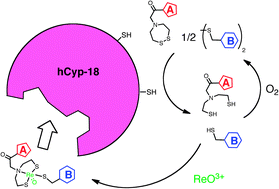Implication of cysteine residues in the selection of oxorhenium inhibitors of cyclophilin hCyp18†
Abstract
The dynamic combinatorial

Maintenance work is planned for Wednesday 1st May 2024 from 9:00am to 11:00am (BST).
During this time, the performance of our website may be affected - searches may run slowly and some pages may be temporarily unavailable. If this happens, please try refreshing your web browser or try waiting two to three minutes before trying again.
We apologise for any inconvenience this might cause and thank you for your patience.
* Corresponding authors
a
CEA, iBiTecS, Service d'Ingénierie Moléculaire des Protéines, bâtiment 152, France
E-mail:
christophe.dugave@cea.fr
Fax: +33 16908 5225
Tel: +33 16908 9071
The dynamic combinatorial

 Please wait while we load your content...
Something went wrong. Try again?
Please wait while we load your content...
Something went wrong. Try again?
 Fetching data from CrossRef.
Fetching data from CrossRef.
This may take some time to load.
Loading related content
